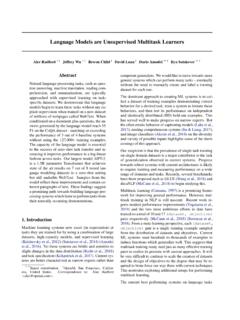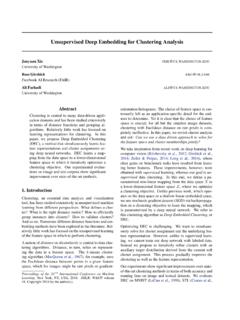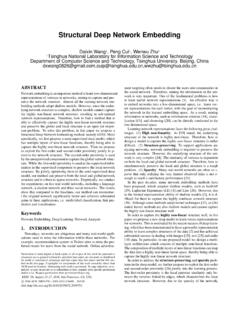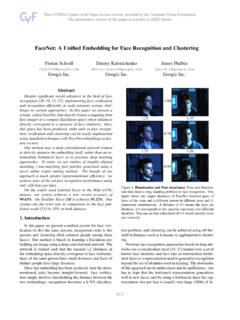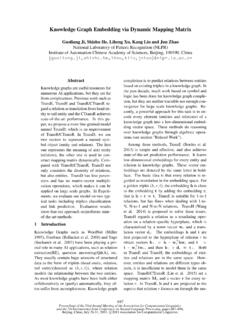Transcription of Knowledge Graph Embedding: A Survey of Approaches and ...
1 1041-4347 (c) 2017 IEEE. Personal use is permitted, but republication/redistribution requires IEEE permission. See for article has been accepted for publication in a future issue of this journal, but has not been fully edited. Content may change prior to final publication. Citation information: , IEEE Transactions on Knowledge and Data Engineering1 Knowledge Graph embedding : A Survey ofApproaches and ApplicationsQuan Wang, Zhendong Mao, Bin Wang, and Li GuoAbstract Knowledge Graph (KG) embedding is to embed components of a KG including entities and relations into continuous vectorspaces, so as to simplify the manipulation while preserving the inherent structure of the KG. It can benefit a variety of downstreamtasks such as KG completion and relation extraction, and hence has quickly gained massive attention.
2 In this article, we provide asystematic review of existing techniques, including not only the state-of-the-arts but also those with latest trends. Particularly, we makethe review based on the type of information used in the embedding task. Techniques that conduct embedding using only facts observedin the KG are first introduced. We describe the overall framework, specific model design, typical training procedures, as well as prosand cons of such techniques. After that, we discuss techniques that further incorporate additional information besides facts. We focusspecifically on the use of entity types, relation paths, textual descriptions, and logical rules. Finally, we briefly introduce how KGembedding can be applied to and benefit a wide variety of downstream tasks such as KG completion, relation extraction, questionanswering, and so Terms Statistical relational learning, Knowledge Graph embedding , latent factor models, tensor/matrix factorization years have witnessed rapid growth in knowledgegraph (KG) construction and application.
3 A large num-ber of KGs, such as Freebase [1], DBpedia [2], YAGO [3],and NELL [4], have been created and successfully appliedto many real-world applications, from semantic parsing [5],[6] and named entity disambiguation [7], [8], to informationextraction [9], [10] and question answering [11], [12]. A KGis a multi-relational Graph composed of entities (nodes) andrelations (different types of edges). Each edge is representedas a triple of the form (head entity,relation,tail entity), alsocalled afact, indicating that two entities are connected bya specific relation, , (AlfredHitchcock,DirectorOf,Psycho). Although effective in representing structured da-ta, the underlying symbolic nature of such triples usuallymakes KGs hard to tackle this issue, a new research direction known asknowledge Graph embeddinghas been proposed and quicklygained massive attention [13], [14], [15], [16], [17], [18], [19].
4 The key idea is to embed components of a KG includingentities and relations into continuous vector spaces, so asto simplify the manipulation while preserving the inherentstructure of the KG. Those entity and relation embeddingscan further be used to benefit all kinds of tasks, such asKG completion [14], [15], relation extraction [20], [21], entityclassification [13], [22], and entity resolution [13], [18].Most of the currently available techniques perform theembedding task solely on the basis of observed facts. Givena KG, such a technique first represents entities and rela-tions in a continuous vector space, and defines a scoringfunction on each fact to measure its plausibility. Entity and , Z. Mao, B. Wang, L. Guo are with the Institute of InformationEngineering, Chinese Academy of Sciences (CAS) and the School ofCyber Security, University of CAS.
5 Q. Wang is also with the State KeyLaboratory of Information Security, embeddings can then be obtained by maximizingthe total plausibility of observed facts. During this wholeprocedure, the learned embeddings are only required to becompatible within each individual fact, and hence might notbe predictive enough for downstream tasks [23], [24]. As aresult, more and more researchers have started to furtherleverage other types of information, , entity types [25],[26], relation paths [27], [28], [29], textual descriptions [30],[31], [32], [33], and even logical rules [23], [34], [35], to learnmore predictive this article, we provide a thorough review of currentlyavailable KG embedding techniques, including those thatuse facts alone, as well as those that further leverage ad-ditional information.
6 We further introduce how the learnedembeddings can be applied to and benefit a wide variety ofentity-oriented tasks. Nickel et al. [36] have made a surveyof statistical relational learning methods on KGs, includingembedding techniques, path ranking algorithms [37], [38],[39], and Markov logic networks [40], [41], [42]. In contrastto their work, we focus specifically on KG embedding , andmake a systematic review of existing techniques, includingnot only the state-of-the-arts but also those with latesttrends. Particularly, we make the review based on the typeof information used in these rest of this article is organized as follows. Section 2briefly introduces basic notations. Section 3 reviews tech-niques that conduct embedding using only facts observed inKGs. We describe the overall framework, specific model de-sign, typical training procedures, as well as pros and cons ofsuch techniques.
7 Section 4 discusses embedding techniquesthat further incorporate other information besides facts. Wefocus on the use of entity types, relation paths, textualdescriptions, and logical rules. Section 5 further exploresthe application of KG embedding in downstream tasks likeKG completion, relation extraction and question , we present our concluding remarks in Section (c) 2017 IEEE. Personal use is permitted, but republication/redistribution requires IEEE permission. See for article has been accepted for publication in a future issue of this journal, but has not been fully edited. Content may change prior to final publication. Citation information: , IEEE Transactions on Knowledge and Data Engineering22 NOTATIONST hroughout this article, we use a boldface lower-case letterxto represent a vector, with itsi-th entry denoted as[x] pnorm of a vector forp 1is denoted as x p, and x 1/2means either the 1norm or the 2norm.
8 Let diag(x)be a diagonal matrix, thei-th diagonal entry of which is[x]i. Let|x|denote the absolute value function,tanh(x)the hyperbolic tangent function, and ReLU(x)the rectifiedlinear unit. All of them are entry-wise operations. A matrixis represented by a boldface upper-case letterX, with itsij-th entry denoted as[X]ij. X Fis the Frobenius norm ofa matrix, tr(X)anddet(X)the trace and determinant of asquare matrix, respectively. We use an underlined boldfacecapital letterXtorepresent a three-mode tensor. Theijk-thentry of a tensor is denoted as[X]ijk. We further useX[i,:,:],X[:,j,:], andX[:,:,k]todenote thei-th,j-th, andk-th slicealong the first, second, and third mode, :Rn Rn Rndenote the Hadamard productbetween two vectors, ,[a b]i= [a]i [b]i,and :Rn Rn Rnthe circular correlation, ,[a b]i=n 1 k=0[a]k [b](k+i) details about these operations, refer to [43], [44].
9 3 KG embedding WITHFACTSALONES uppose we are given a KG consisting ofnentities andmrelations. Facts observed in the KG are stored as a collectionof triplesD+={(h, r, t)}. Each triple is composed of a headentityh E, a tail entityt E, and a relationr Rbetweenthem, , (AlfredHitchcock,DirectorOf,Psycho).Here ,Edenotes the set of entities, andRthe set of embedding aims to embed entities and relations into alow-dimensional continuous vector space, so as to simplifycomputations on the KG. Most of the currently availabletechniques use facts stored in the KG to perform the embed-ding task, enforcing embedding to be compatible with typical KG embedding technique generally consists ofthree steps: (i) representing entities and relations, (ii) defin-ing a scoring function, and (iii) learning entity and relationrepresentations.
10 The first step specifies the form in whichentities and relations are represented in a continuous vectorspace. Entities are usually represented as vectors, , deter-ministic points in the vector space [13], [14], [15], [16], [19].Recent work in [45] further takes into account uncertaintiesof entities, and models them through multivariate Gaussiandistributions. Relations are typically taken as operations inthe vector space, which can be represented as vectors [14],[15], matrices [16], [18], tensors [19], multivariate Gaussiandistributions [45], or even mixtures of Gaussians [46]. Then,in the second step, a scoring functionfr(h, t)is defined oneach fact(h, r, t)to measure its plausibility. Facts observedin the KG tend to have higher scores than those that havenot been observed.
